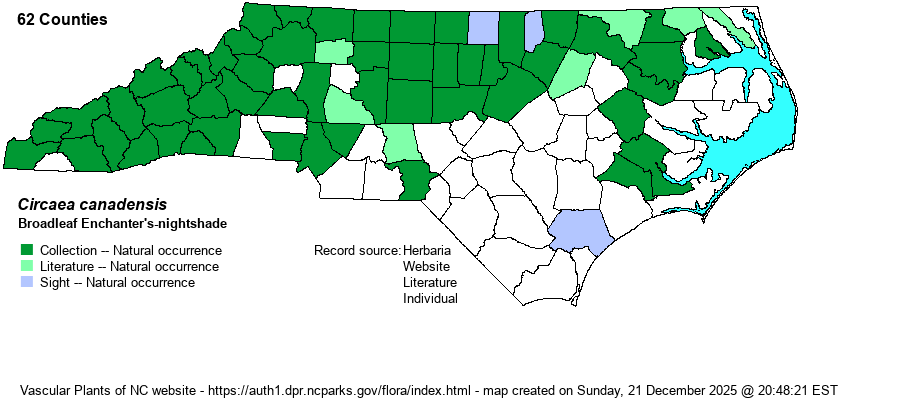| Author | (L.) Hill | |
| Distribution | Throughout the Mountains, and essentially throughout the Piedmont also, but scarce in the southeastern portion; present in the Coastal Plain, but mainly in the northern half, south to Pender County.
This is a very widespread species of the Northeast, found over much of eastern Canada, south to central NC, and the central parts of AL, MS, and into LA. | |
| Abundance | Frequent to common across the Mountains, and most of the Piedmont, except rare in the far southeastern portions. Rare to uncommon in the northern and central Coastal Plain. Seemingly absent in the far eastern and the southwestern parts of the Coastal Plain (including the Sandhills). Two widely separated populations occur in rich floodplain forests by Pee Dee River in the Piedmont of Richmond County. | |
| Habitat | This is a species of rich hardwood forests, both in bottomlands and on lower slopes, such as in Basic Mesic Forests and Rich Cove Forests; also it can be found into Mesic Mixed Hardwood Forests. |
| Phenology | Blooms from June to August, and fruits shortly after flowering. | |
| Identification | This is a familiar species to biologists in the mountains and Piedmont, found in many a rich forest. It is an erect herb, mostly unbranched, growing to 1-1.5 feet tall. The several pairs of opposite leaves are at right angles to pairs above or below them, and each leaf has a moderate petiole, a widely ovate blade, with a truncate base and small serrations. The blades are 3-4 inches long and about 2 inches wide. Along the top several inches of the stem, as well as in one or two upper leaf axils, grows a slender raceme of quite small flowers. Each flower has only 2 parts each, with the 2 white petals (each one split into two lobes) creating a flower barely 1/5-inch across. The similar but smaller C. alpina grows mainly at elevations above this species, its leaves are cordate at the base, and have sharper teeth. Actually, in vegetative form, this species can be confused with the completely unrelated American Lopseed (Phryma leptostachya), and you may need to see a plant in bloom or fruit to be sure; each has paired ovate leaves with truncate bases, some serrations on the margins, and adjacent pairs of leaves at right angles. Lopseed has narrow, rather tubular flowers, and after blooming "lop" down to the stem. Also, both occur in rich hardwoods forests and have similar ranges! Circaea has tiny but quite exquisite flowers, but you need to get on hands and knees to study the 2-parted flower structure. | |
| Taxonomic Comments | The species was formerly named at C. lutetiana, and this taxon was named as C. lutetiana var. canadensis. Weakley (2018) has much to say about the taxonomic "mess" of the C. lutetiana/canadensis complex.
| |
| Other Common Name(s) | Canada Enchanter's-nightshade | |
| State Rank | S5 | |
| Global Rank | G5 | |
| State Status | | |
| US Status | | |
| USACE-agcp | FACU link |
| USACE-emp | FACU link |

